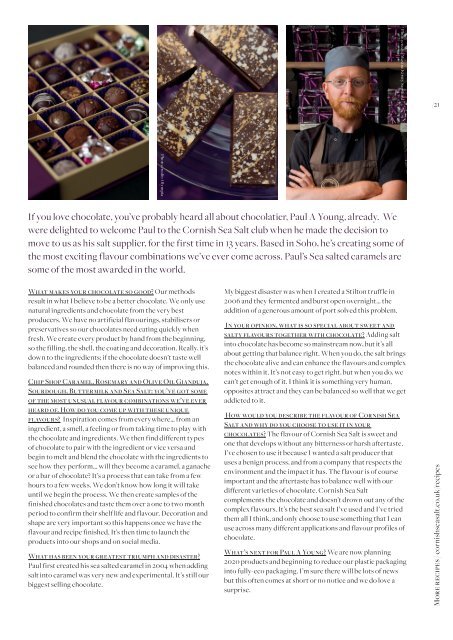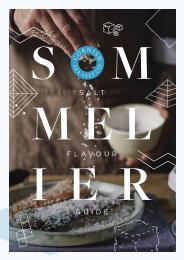Seasoned Autumn/Winter 2019
* Preserving the Harvest * Sweet & Salty * Seasoned Greetings * Sea Salt Differently
* Preserving the Harvest
* Sweet & Salty
* Seasoned Greetings
* Sea Salt Differently
Create successful ePaper yourself
Turn your PDF publications into a flip-book with our unique Google optimized e-Paper software.
Photo credit: Maxine Kirsty Sapsford<br />
/21<br />
Photo credit: Olympia<br />
If you love chocolate, you’ve probably heard all about chocolatier, Paul A Young, already. We<br />
were delighted to welcome Paul to the Cornish Sea Salt club when he made the decision to<br />
move to us as his salt supplier, for the first time in 13 years. Based in Soho, he’s creating some of<br />
the most exciting flavour combinations we’ve ever come across. Paul’s Sea salted caramels are<br />
some of the most awarded in the world.<br />
What makes your chocolate so good? Our methods<br />
result in what I believe to be a better chocolate. We only use<br />
natural ingredients and chocolate from the very best<br />
producers. We have no artificial flavourings, stabilisers or<br />
preservatives so our chocolates need eating quickly when<br />
fresh. We create every product by hand from the beginning,<br />
so the filling, the shell, the coating and decoration. Really, it’s<br />
down to the ingredients; if the chocolate doesn’t taste well<br />
balanced and rounded then there is no way of improving this.<br />
Chip Shop Caramel, Rosemary and Olive Oil Gianduja,<br />
Sourdough, Buttermilk and Sea Salt: you’ve got some<br />
of the most unusual flavour combinations we’ve ever<br />
heard of. How do you come up with these unique<br />
flavour s? Inspiration comes from everywhere… from an<br />
ingredient, a smell, a feeling or from taking time to play with<br />
the chocolate and ingredients. We then find different types<br />
of chocolate to pair with the ingredient or vice versa and<br />
begin to melt and blend the chocolate with the ingredients to<br />
see how they perform… will they become a caramel, a ganache<br />
or a bar of chocolate? It’s a process that can take from a few<br />
hours to a few weeks. We don’t know how long it will take<br />
until we begin the process. We then create samples of the<br />
finished chocolates and taste them over a one to two month<br />
period to confirm their shelf life and flavour. Decoration and<br />
shape are very important so this happens once we have the<br />
flavour and recipe finished. It’s then time to launch the<br />
products into our shops and on social media.<br />
What has been your greatest triumph and disaster?<br />
Paul first created his sea salted caramel in 2004 when adding<br />
salt into caramel was very new and experimental. It’s still our<br />
biggest selling chocolate.<br />
My biggest disaster was when I created a Stilton truffle in<br />
2006 and they fermented and burst open overnight… the<br />
addition of a generous amount of port solved this problem.<br />
In your opinion, what is so special about sweet and<br />
salty flavours together with chocolate? Adding salt<br />
into chocolate has become so mainstream now, but it’s all<br />
about getting that balance right. When you do, the salt brings<br />
the chocolate alive and can enhance the flavours and complex<br />
notes within it. It’s not easy to get right, but when you do, we<br />
can’t get enough of it. I think it is something very human,<br />
opposites attract and they can be balanced so well that we get<br />
addicted to it.<br />
How would you describe the flavour of Cornish Sea<br />
Salt and why do you choose to use it in your<br />
chocolates? The flavour of Cornish Sea Salt is sweet and<br />
one that develops without any bitterness or harsh aftertaste.<br />
I’ve chosen to use it because I wanted a salt producer that<br />
uses a benign process, and from a company that respects the<br />
environment and the impact it has. The flavour is of course<br />
important and the aftertaste has to balance well with our<br />
different varieties of chocolate. Cornish Sea Salt<br />
complements the chocolate and doesn’t drown out any of the<br />
complex flavours. It’s the best sea salt I’ve used and I’ve tried<br />
them all I think, and only choose to use something that I can<br />
use across many different applications and flavour profiles of<br />
chocolate.<br />
What’s next for Paul A Young? We are now planning<br />
2020 products and beginning to reduce our plastic packaging<br />
into fully-eco packaging. I’m sure there will be lots of news<br />
but this often comes at short or no notice and we do love a<br />
surprise.<br />
More recipes / cornishseasalt.co.uk/recipes<br />
CSS0029_CSS_SEASONED AUTUMN_WINTER <strong>2019</strong> HRAW.indd 21 06/09/<strong>2019</strong> 12:27




